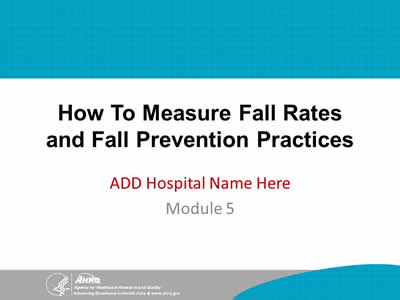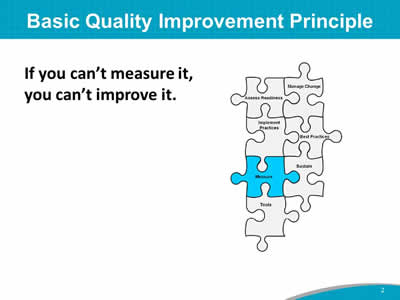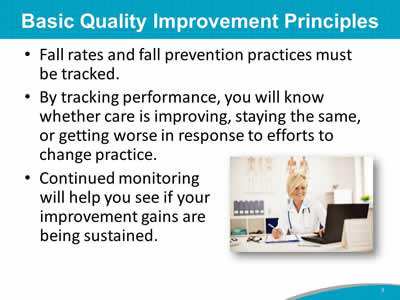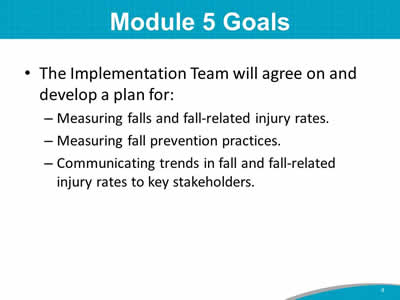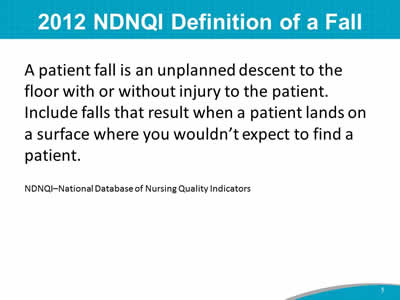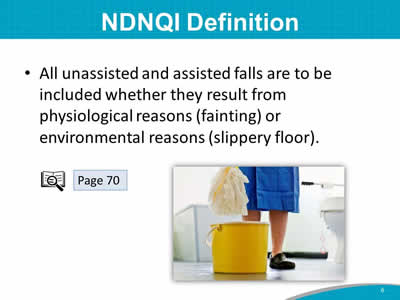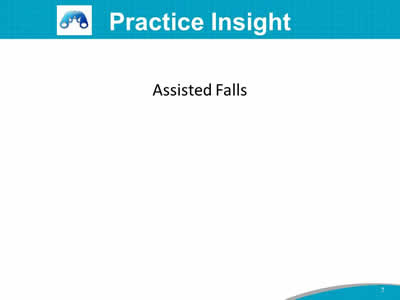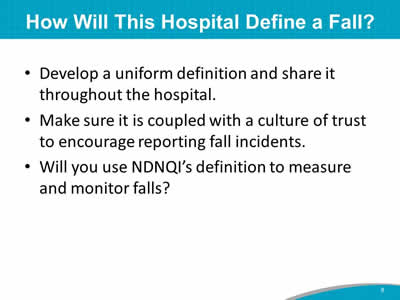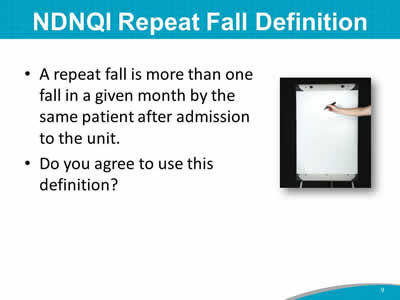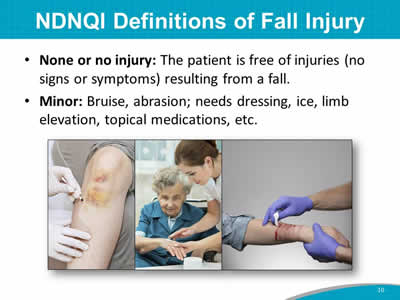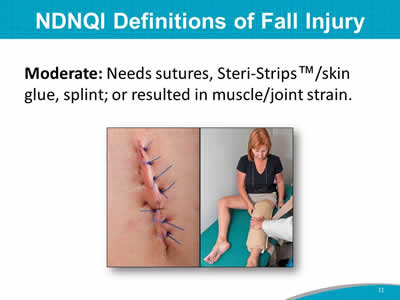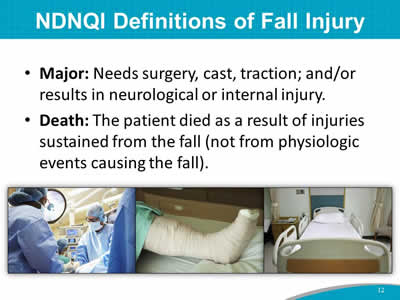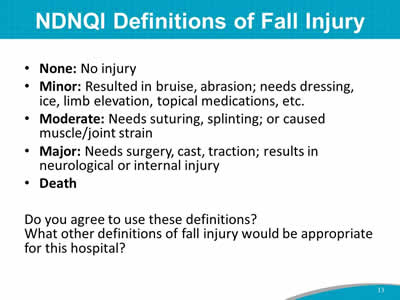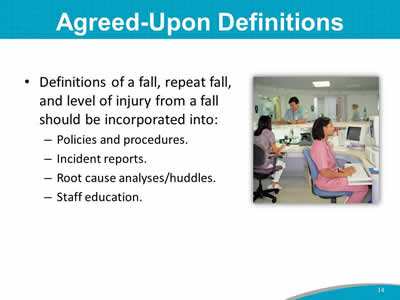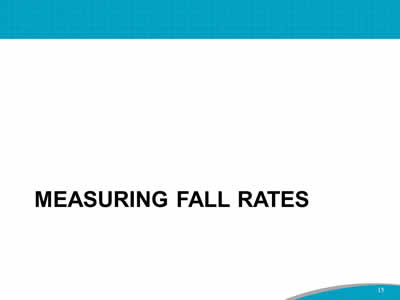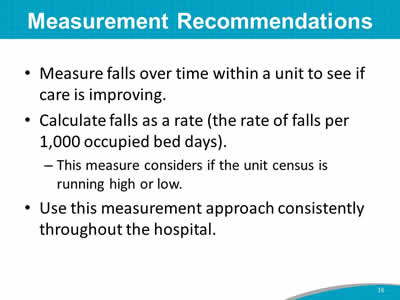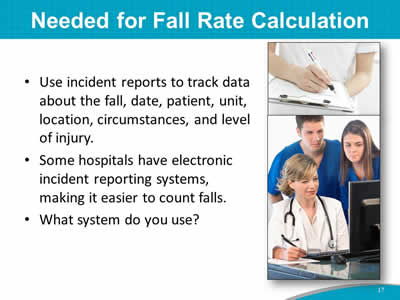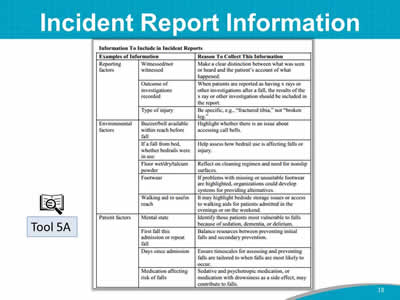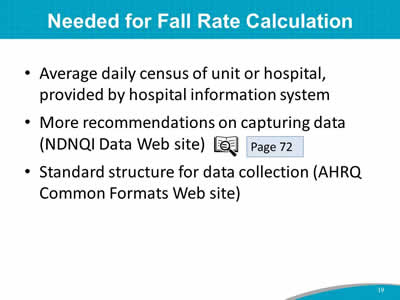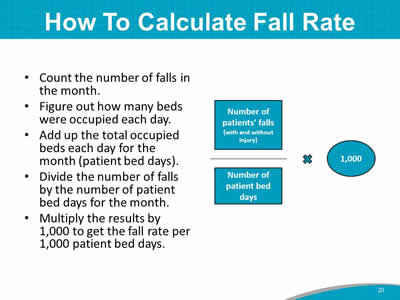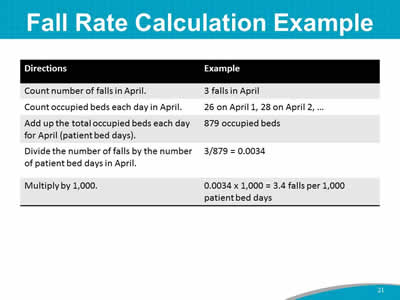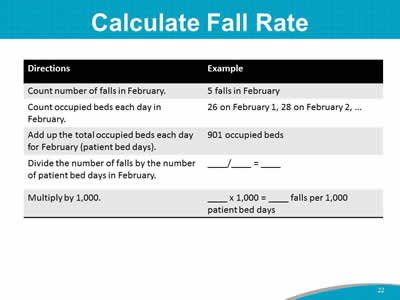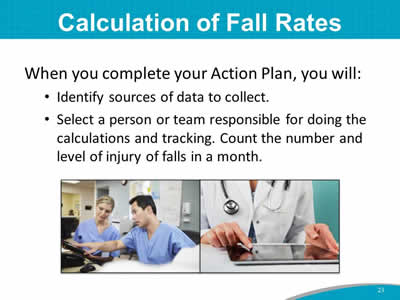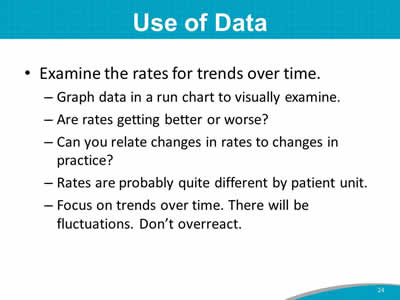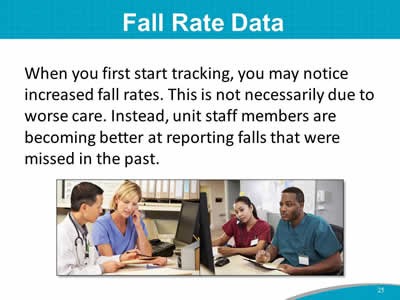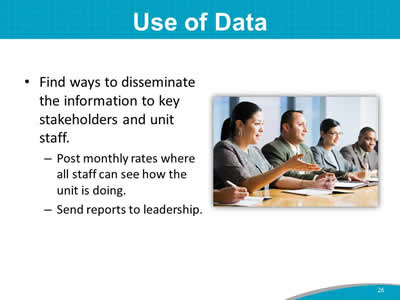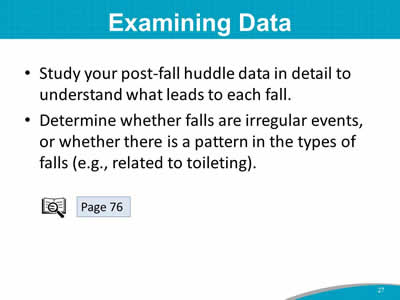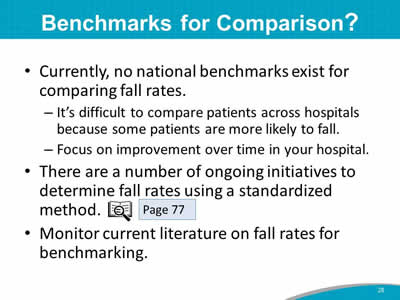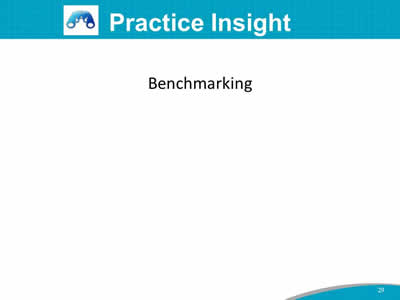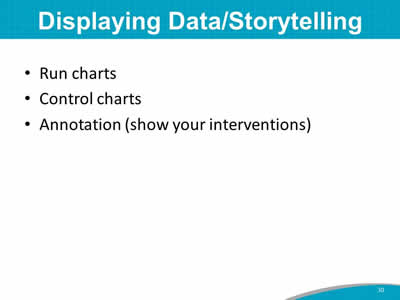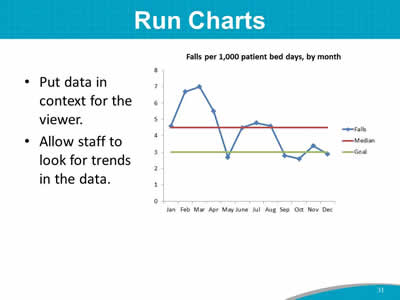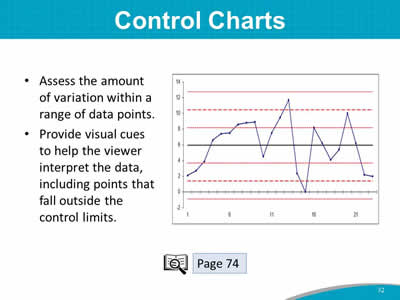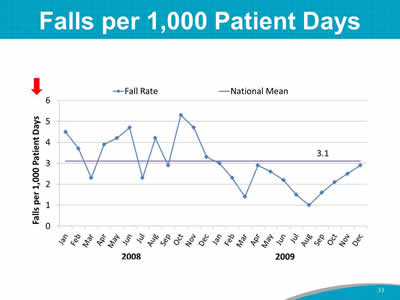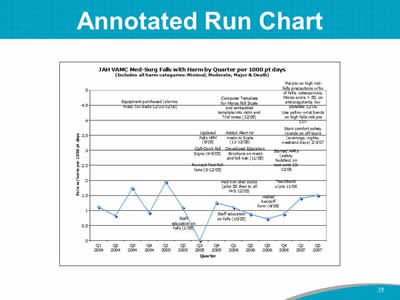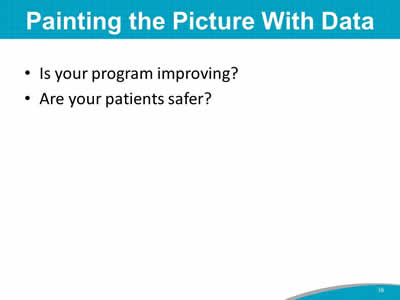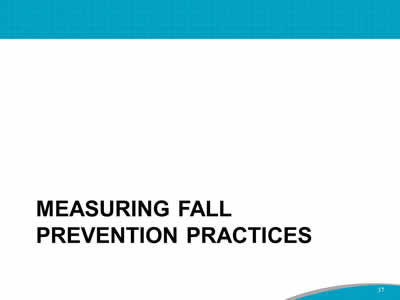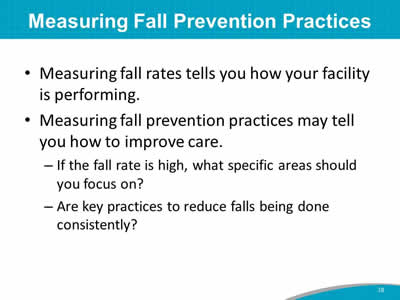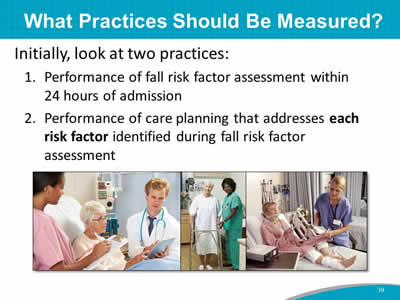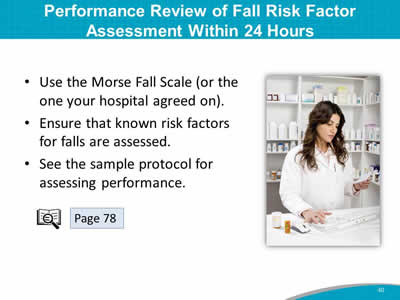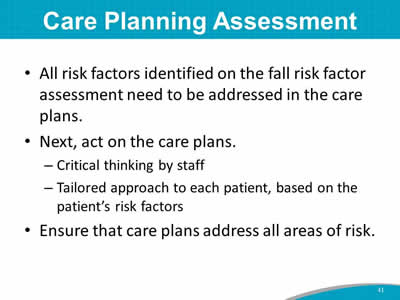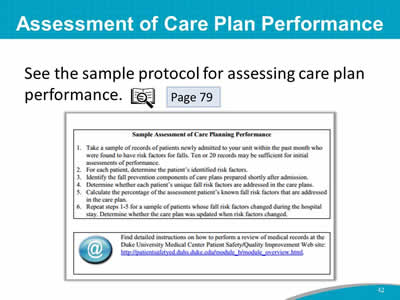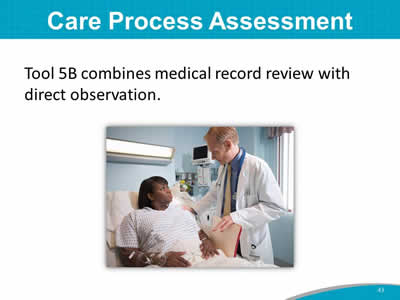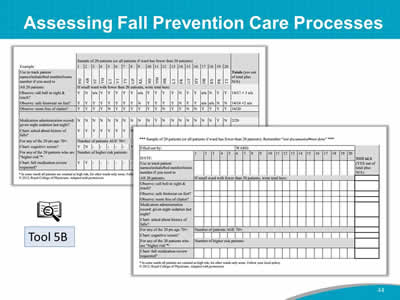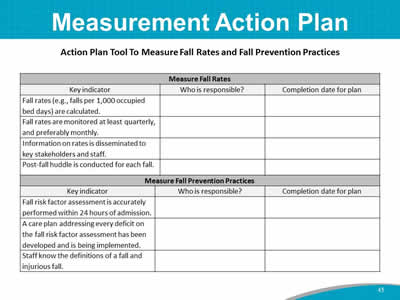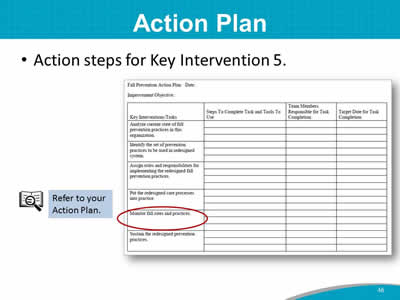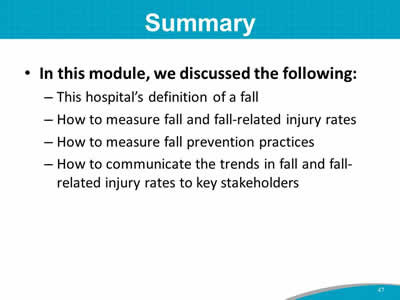Module 5: How To Measure Fall Rates and Fall Prevention Practices—Training Guide
Module Aim
The aim of this module is to support your efforts to measure and monitor fall rates and fall prevention practices.
Module Goals
The goals of Module 5 are to have the Implementation Team agree on and develop a plan for measures to track fall rates, fall prevention practices, and communication of trends by answering the following questions:
- How do you measure fall and fall-related injury rates?
- How do you measure fall prevention practices?
- How will you communicate the trends in fall and fall-related injury rates to key stakeholders?
Timing
This module will take 90 minutes to present.
Below is the estimated time needed to present each topic:
| Slide numbers | Topic | Time in minutes |
|---|---|---|
| 1–14 | Introduction | 15 |
| 15–36 | Measuring Fall Rates | 25 |
| 37–44 | Measuring Fall Prevention Practices | 15 |
| 45–46 | Action Plan Activity | 30 |
| 47–48 | Summary and Next Steps | 5 |
Learning Methodology Checklist
- Large group discussion.
- PowerPoint slide presentation.
- Group planning activities.
Additional Related Training Resources
- Measuring Fall and Fall-Related Injury Rates and Prevention Practices—AHRQ Fall Prevention Program Training Webinar.
- Creating Control Charts To Interpret Fall Data—AHRQ Fall Prevention Program Implementation Sharing Webinar.
- Measurement: Using Data To Tell a Story—AHRQ Fall Prevention Program Implementation Sharing Webinar.
- Bouldin ED, Andresen EM, Dunton NE, et al. Falls among adult patients hospitalized in the United States: prevalence and trends. J Patient Saf 2013 March;9(1):13–17. https://www.ncbi.nlm.nih.gov/pmc/articles/PMC3572247/. Accessed June 30, 2017.
Materials Checklist
- LCD projector and laptop.
- “Parking Lot” flip chart (with tape or sticky band) and markers.
Instructor Preparation
- Add the specific hospital name to the first slide.
- Participants should have Tool 2F: Action Plan available, as they will add to it in this module.
- Ask the Implementation Team Leader to write the hospital’s definitions of a fall, repeat fall, and fall with injury on the flip chart, before you begin the training. (You will share these definitions during Slide 5.)
- Alert the Implementation Team Leader or designee (as well as a representative from the QI Team, if appropriate) that he/she/they will be leading a group activity to complete the Action Plan Tool To Measure Fall Rates and Fall Prevention Practices.
- Have the PowerPoint file Module 5 cued on the computer and minimized.
- Have a copy of the following materials for all participants:
- The hospital’s Incident Report, if available.
- Tool 5A: Information To Include in Incident Reports.
- Tool 5B: Assessing Fall Prevention Care Processes.
- Action Plan Tool To Measure Fall Rates and Fall Prevention Practices.
Module 5: How To Measure Fall Rates and Fall Prevention Practices
| Slide | Script |
|---|---|
|
Slide 1
|
Say: In this last module, we will discuss how to measure fall rates and fall prevention practices. This tracking of key indicators is critical to improving prevention practices in this hospital. |
|
Slide 2
|
Say: A basic principle of quality improvement is: If you can’t measure it, you can’t improve it. |
|
Slide 3
|
Say: Fall rates and fall prevention practices must be counted and tracked as one component of a quality improvement program. By tracking performance, you will know whether care is improving, staying the same, or getting worse in response to efforts to change practice. Continued monitoring will help you understand where you are starting from and whether your improvement gains are being sustained. |
|
Slide 4
|
Say: The goals of Module 5 are to have the Implementation Team agree on and develop a plan for measures to track fall rates, fall prevention practices, and communication of trends by answering the following questions:
|
|
Slide 5
|
Do: Ask the Implementation Team Leader to write the hospital’s definitions of a fall, repeat fall, and fall with injury on the flip chart prior to the training. Say: Hospital definitions of falls are important when measuring and tracking fall rates. In 2012, the National Database of Nursing Quality Indicators, or NDNQI, defined a fall with specific terminology. It states: “A patient fall is an unplanned descent to the floor with or without injury to the patient. Include falls that result when a patient lands on a surface where you wouldn’t expect to find a patient.” |
|
Slide 6
|
Say: The NDNQI definition also includes: All unassisted and assisted falls, whether they result from physiological reasons (fainting) or environmental reasons (slippery floor). Also report patients that roll off a low bed onto a mat as a fall. This definition and a link to the NDNQI Web site are found on page 70 of the Toolkit. |
|
Slide 7
|
Say: Hospital leaders in an acute-care hospital noticed that staff were reluctant to consider and count assisted falls as falls—particularly on rehab units where patients were being appropriately encouraged and tested to increase mobility. Leaders continued to support counting and reporting of assisted falls to be transparent and consistent with NDNQI definitions but also began tracking the number of assisted falls for quality improvement and measurement purposes. Assisted falls usually are associated with less injury. When falls occur with assistance, it suggests that staff have identified at-risk patients and are in attendance during mobilization activities—two important processes of care. |
|
Slide 8
|
Say: You will want to decide on a uniform definition of a fall and share it throughout the hospital. Your fall definition also needs to be coupled with a culture of trust in which reporting falls is encouraged. Ask: Do you agree with the NDNQI definition of a fall? Will this definition of a fall be the one this hospital uses for measuring and monitoring fall rates? Instructor’s Note: If the Team does not agree to use the NDNQI definition and/or prefers to continue with their current definition, ask the Team Leader to walk through the hospital’s definition of a fall, and then discuss how it is similar to or different from the NDNQI definition. Do: Write the agreed-upon definition on the flip chart. Say: This is the definition you have agreed to use. |
|
Slide 9
|
Say: NDNQI defines a repeat fall as: More than one fall in a given month by the same patient after admission to the unit. Ask: Do you agree with this definition of a repeat fall? Will this be the definition of a repeat fall this hospital uses for measuring and monitoring fall rates? Instructor’s Note: If the Team does not agree to use this definition or prefers to continue with their current definition, discuss the differences between their definition and NDNQI’s definition, as explained in the previous slide. Do: Write the agreed-upon definition on the flip chart. Say: This is the definition you have agreed to use. |
|
Slide 10
|
Say: NDNQI also discusses fall injury. It defines the first level of injury from a fall as:
It defines the second level of injury as:
|
|
Slide 11
|
Say: It defines the third level of injury as:
|
|
Slide 12
|
Say: NDNQI defines the fourth and fifth levels of injury as:
|
|
Slide 13
|
Say: Here are the five categories again on one slide for your review. Ask: Do you agree with these definitions of injury from a fall? Will this hospital use these definitions for measuring and monitoring fall rates? Instructor’s Note: If the Team does not agree to use these definitions, ask them what definitions they will use for fall injuries. Do: Write the agreed-upon definitions on the flip chart. Say: These are the definitions you have agreed to use. |
|
Slide 14
|
Say: These agreed-upon definitions (of fall, repeat fall, and level of injury resulting from a fall) should be used uniformly throughout the hospital and incorporated into:
|
|
Slide 15
|
|
|
Slide 16
|
Say: The best measure of falls is one that can be compared over time within a hospital unit to see if care is improving. It is recommended that you calculate falls as a rate and not simply as the total number of falls in a given timeframe. Calculating a rate allows you to take into consideration how full or empty the unit was during a given timeframe. Specifically, use the rate of falls per 1,000 occupied bed days. Most importantly, be consistent in how you calculate fall rates over time and throughout the hospital. |
|
Slide 17
|
Say: To calculate fall and fall-related injury rates, you need to know:
Then, enter this information into an incident report. Explore this hospital’s incident reporting system. You may have an electronic incident reporting system that will make it easier to count the number of falls. Find mechanisms to communicate fall incident report information to the Implementation Team, such as a weekly meeting, daily huddle, interoffice memo, or secure email. Ask: What system do you currently use for incident reporting? |
|
Slide 18
|
Say: To evaluate the completeness of this hospital’s incident report, please use Tool 5A: Information To Include in Incident Reports. Make sure that the data you need to track fall rates are included in your incident report. For example, you may consider adding specific fields for contributing factors to falls (such as high-risk medications). |
|
Slide 19
|
Say: You also need to know the daily census on the unit where you would like to calculate the fall rate. To learn more about recommendations for capturing data on falls, refer to the resources on page 72 of the Toolkit. Included in these resources is the AHRQ Common Formats Web site, which links to a standard structure for collecting data for a fall-related incident report. |
|
Slide 20
|
Say: This slide shows an approach for calculating fall rates. First, count the number of falls that occurred during the month from your incident reporting system. Count all falls, including those resulting in injury. Then, figure out for each day of the month how many beds were occupied on the unit. Add up the total occupied beds each day, or patient bed days. Divide the number of falls by the number of occupied beds for the month. Multiply the result you get by 1,000 to get the fall rate per 1,000 patient bed days. |
|
Slide 21
|
Say: Here is an example of a fall rate calculation:
|
|
Slide 22
|
Say: It is fairly straightforward to calculate a hospital’s fall rate. Following the directions, let’s calculate the fall rate for this example from a hospital during the month of February.
The fall rate is 5.55 falls per 1,000 patient bed days. You calculate the fall with injury rate in exactly the same way, except you count only the number of falls that resulted in injury. |
|
Slide 23
|
Say: When we address the Action Plan for measurement at the end of this module, you will identify a person or a team that will be responsible for identifying sources of data to collect, as well as doing these calculations and tracking over time. The person or team responsible for putting together a plan for tracking falls in the hospital will also want to track the level of injury sustained in each fall. When hospitals know their fall rate by type of injury, they begin to get a picture of the severity of the falls and where the most injurious falls occur. Most importantly, a hospital can track the causes of falls via post-fall huddles or root cause analyses. The causes of falls should drive interventions to prevent repeat falls. |
|
Slide 24
|
Say: Examining monthly or quarterly data on falls can be very useful. First, calculate your rates every month and look at the trend over time. How are the rates changing? Are they improving or getting worse? Can you relate changes in fall rates, including the rates of different types of falls, to changes in practice? Fall rates may change based on the season or month of the year. For example, there may be more falls during winter months. Fall rates may also vary by unit. For example, a geriatric psychiatry unit may have different rates than an intensive care unit. Focus on the underlying trend of the data over time. There will be fluctuations. Don’t overreact to any individual month’s data. |
|
Slide 25
|
Say: Please note that when you first implement a quality improvement program and begin tracking performance, increased fall rates are frequently seen. With increased awareness and education, unit staff members are encouraged to report, and they are becoming better at recognizing falls. |
|
Slide 26
|
Say: You will want to disseminate your data on falls to key stakeholders and unit staff.
Dissemination of information on performance is critical to your quality improvement effort. Ask: How do you currently share this hospital’s fall data? Are you reaching everyone who should know about its fall rates? |
|
Slide 27
|
Say: The third way to use your data is to study in detail what led to the occurrence of each fall, particularly falls resulting in injury. Try to understand why the fall occurred and how such an incident might be prevented in the future. Try to determine whether the falls are irregular unanticipated events (such as a patient’s first seizure that resulted in a fall), or whether there is a pattern to the types of falls. For example, falls related to toileting suggest a specific intervention is needed to improve care. Post-fall huddles are useful techniques for understanding reasons for failures in the system. Refer to page 76 of the Toolkit for additional resources regarding root cause analysis and huddles. |
|
Slide 28
|
Say: You may be wondering how well this hospital is performing compared with other hospitals. Unfortunately, there are no national benchmarks with which to compare your performance. That’s because of the difficulties in comparing patients across hospitals, since some patients are more likely to fall than others. The best bet is to focus on improvement over time within your hospital units. There are many ongoing initiatives to determine fall rates using a standardized method across many hospitals. To learn more about these initiatives, see page 77 of the Toolkit. Continually monitor the peer-reviewed literature on updated fall prevalence rates for benchmarking purposes. Instructor’s Note: Below is a 2013 peer-reviewed article that could be used for hospital unit-specific benchmarking rates. Bouldin ED, Andresen EM, Dunton NE, et al. Falls among adult patients hospitalized in the United States: prevalence and trends. J Patient Saf 2013 March; 9(1):13–17. https://www.ncbi.nlm.nih.gov/pmc/articles/PMC3572247/. Accessed June 30, 2017. |
|
Slide 29
|
Say: One hospital benchmarked against itself by comparing its data before and after implementing a Fall Prevention Program. The data showed a reduction in falls with major injury from 6 in 2014 to 4 in 2015 and 1 in 2016. The data also showed a reduction in fall rates for both the entire hospital system and the pilot units. Many of the interventions found to be successful on the pilot units are now being spread to other units. Interventions to prevent falls and fall injuries are tracked. These include low beds, fall mats, helmets, and hip protectors. |
|
Slide 30
|
Say: Data are more than just numbers. For instance, they can show you if your program is improving. Some ways to display data in a way that tells a story are run charts, control charts, and annotated run charts. The next 3 slides show examples of how to display data. |
|
Slide 31
|
Say: Run charts simply display a series of data points over time. The individual data points are plotted and then connected (as shown by the blue line) to show that they occurred in order. Run charts can be used to determine if a process is changing, including whether it is responding to a quality improvement initiative. In addition to showing the data of interest, in this case your mean fall rate data, there is usually a summary statistic plotted, like the mean or the median, as well as a goal. Run charts can help you look for trends and/or variability in your rates over time. |
|
Slide 32
|
Say: Control charts are a special type of run chart. They have a central line depicting the average rate over time, shown in this chart by the central black line. Control charts also display upper and lower control limits (the dashed parallel lines) that are calculated using all of the data included in the plot. The limits are based in probability and take into account the variability of the data in the chart. Control charts help you understand whether the changes you are seeing are within or outside the range of normal variation. We aren’t going to spend any more time on control charts today. For a more indepth look at how to use control charts to analyze data on fall rates, see page 74 of the Toolkit. |
|
Slide 33
|
Say: Let’s take a look at another run chart and talk about how we can begin to use data to tell a story. This slide shows a run chart depicting the number of falls per 1,000 patient days over a 2-year timeframe. Also plotted in this figure is the national average. For this hospital, you can see that during 2008, the hospital’s fall rate is fluctuating and a little above the national average, shown as 3.1 falls per 1,000 patient days. Then, starting in January of the second year, the fall rate is below the national average or benchmark. The rate varies over time, but falls appear to be decreasing from the previous year. |
|
Slide 34
|
Say: This run chart again shows the same fall rate data from the previous slide (blue line). However, it also shows a breakdown of the fall rate by the different types of falls that occurred—anticipated falls, accidental falls, unanticipated falls, and intentional falls. You can see that in this chart, most falls are anticipated physiological falls (the red line). In other words, they are preventable. |
|
Slide 35
|
Say: Another way to present your data is by using an annotated run chart. Capturing your fall improvement interventions and creating a storyboard such as the one shown in this slide helps you to look for trends and variation in your data relative to your specific implementation efforts. |
|
Slide 36
|
Say: Use data to paint the picture. Is your program improving because of your QI initiative? When you plot your fall data over time, especially in an annotated run chart, you can see how the fall rate has changed over time. You can also see how fall rates change in response to implementing prevention strategies and, importantly, if results are being sustained over time. Do: Suggest that those who are doing the data collection and analysis view the following webinars for more information:
|
|
Slide 37
|
Say: We can understand why we need to track fall rates in our hospital. Fall rates are outcome measures. Why would we be interested in measuring fall prevention practices? |
|
Slide 38
|
Say: Measuring fall rates tests how your hospital or unit is performing, but fall rates are limited in that they do not tell you how to improve care. For example, if your fall rate is high, what specific areas should you focus your energies on? To know where to focus improvement efforts, it is important to measure whether key practices to reduce falls are being done correctly and in a timely manner. If you are not doing well in any key area, it provides an opportunity for improvement. Tracking process measures helps us assess if we are making the changes we intended to make in our Action Plan and if they are making a difference. Change will not happen if staff are not implementing practices as intended. |
|
Slide 39
|
Say: Many important practices could be measured in assessing fall prevention, but let’s focus on a couple of practices to begin. The two practices recommended in the AHRQ Toolkit to initially look at are:
|
|
Slide 40
|
Say: As the first step in prevention, it is essential to ensure that a fall risk factor assessment is accurately performed within 24 hours of admission. You will be using the Morse Fall Scale. Instructor’s Note: The hospital may have agreed to use another scale or a simple checklist of risk factors for falls in the hospital. If so, refer to that instead of the Morse Fall Scale. Say: Look at the sample protocol for assessing performance of fall risk factor assessment on page 78 of the Toolkit. |
|
Slide 41
|
Say: For risk factor assessment to make a difference, all risk factors identified on the risk factor assessment need to be addressed in the care plans. And the care plans need to be acted on. This requires critical thinking on the part of staff and a tailored approach to each patient based on the individual patient’s risk factors. Ensure that the care plans address all areas of risk. |
|
Slide 42
|
Say: Look at the sample protocol for assessing care plan performance on page 79 of the Toolkit. This will be the second prevention practice to be monitored and tracked. |
|
Slide 43
|
Say: Tool 5B combines medical record review with direct observation to assess if and how fall prevention care processes were carried out. |
|
Slide 44
|
Say: As a starting point, it is recommended that you combine medical record review with direct observation, using a manageable sample size, as suggested in Tool 5B: Assessing Fall Prevention Care Processes. |
|
Slide 45
|
Say: Let’s pull it all together with an Action Plan for measuring progress. Please take out the Action Plan Tool To Measure Fall Rates and Fall Prevention Practices. Do: Ask the Implementation Team Leader or designee to lead this activity. Have him/her go through each of the key indicators on the tool. With the help of the Team, he/she should fill in the responsible person or group and the expected date of completion. |
|
Slide 46
|
Say: Now that we have a preliminary fall measurement Action Plan, let’s end this module by folding this information into Key Intervention 5 of the overall Fall Prevention Program Action Plan. Say: Key Intervention 6, sustain the redesigned prevention practices, is the only key intervention that you have not yet addressed. You will complete an Action Plan for sustainment at one of your upcoming Team meetings. By using your talent, skills, and expertise, you have developed a preliminary Action Plan as a framework for the Fall Prevention Program. This is a major 1-day achievement. Think of this Action Plan as a blueprint for implementing this initiative. |
|
Slide 47
|
Say: To summarize your success in this module, we discussed the following:
|
|
Slide 48
|
Say: Today, you made great progress in beginning to develop an implementation plan for fall prevention in this hospital. Your draft Action Plan covers the key interventions you plan to use, who is responsible for the plans, and when they will be completed. This is your launching pad for your program. Over the next several weeks we will meet weekly for focused discussions on:
Thank you for your participation on the fall prevention Implementation Team and your efforts to make this hospital safer for patients. |
Action Plan Tool To Measure Fall Rates and Fall Prevention Practices
| Measure Fall Rates | ||
|---|---|---|
| Key indicator | Who is responsible? | Completion date for plan |
| Fall rates (e.g., falls per 1,000 occupied bed days) are calculated. | ||
| Fall rates are monitored at least quarterly, and preferably monthly. | ||
| Information on rates is disseminated to key stakeholders and staff. | ||
| Post-fall huddle is conducted for each fall. | ||
| Measure Fall Prevention Practices | ||
|---|---|---|
| Key indicator | Who is responsible? | Completion date for plan |
| Fall risk factor assessment is accurately performed within 24 hours of admission. | ||
| A care plan addressing every deficit on the fall risk factor assessment has been developed and is being implemented. | ||
| Staff know the definitions of a fall and injurious fall. | ||




